Green Mitzvah
Air Date: Week of February 27, 2009
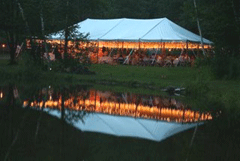
The solar-powered setting. (Photo: Charles Kozierok)
Bar Mitzvahs mark the passage from youth to adulthood in the Jewish religion. A new movement to plan "green" Bar Mitzvahs is producing some creative ideas and returning Jews to the tradition of caring for the Earth. Host Bruce Gellerman speaks with author Kate Harrison and recent Bar Mitzvah Brendan Eprile.
Transcript
GELLERMAN: These days it seems everything is going green: green cars, green homes, green energy and –oy, Green Bar Mitzvahs?
[MUSIC: “HAVA NAGILAH…”]
GELLERMAN: According to Jewish tradition a bar mitzvah marks a child’s rite of passage into adulthood.
The ceremony is a solemn affair - but afterwards—there are often blow out parties with tons of food, and Meshugana themes.
You can have a James Bond bar mitzvah - Vegas casino bar mitzvahs - even an oxygen bar…bar mitzvah.
Now, there’s a small but growing, sustainable bar mitzvah movement.
Kate Harrison operates greenbarmitzvahs.com. Kate, shalom!
HARRISON: Thanks so much for having me.
GELLERMAN: So give me some examples. How do you make a green bar mitzvah?
HARRISON: Well, you mentioned the food – oy, right?
[LAUGHING]
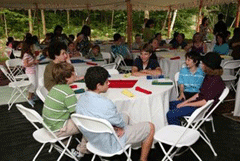
Brendan waits with friends for food to be served on compostable plates. (Photo: Charles Kozierok)
HARRISON: Every bar mitzvah has food, this huge celebration – food is really at the center of the Jewish life. And by choosing local foods, seasonal foods, organic foods you can have all the things you’re used to having, but in a green way, a way that doesn’t harm the earth.
GELLERMAN: But you still get to have a lot of food.
HARRISON: Oh yeah. You can have tons of food. And leftovers are fine. Send them home in boxes made from recycled cardboard.
GELLERMAN: I was looking at your website and some people came up with center pieces with can goods that they would then donate to a food pantry. What a great idea.
HARRISON: Yeah. I love this idea. And some of the sculptures that you can make out of canned goods are really beautiful.
GELLERMAN: Can-ny Youngman [Laughing]
HARRISON: Yeah. [Laughing] And it doesn’t have to just be can goods. I saw another one – someone wrote in about where they used stuff animals, but just the idea that you’re – instead of just using flowers for your center piece that you have something that you can then donate to the community or use for change or good.
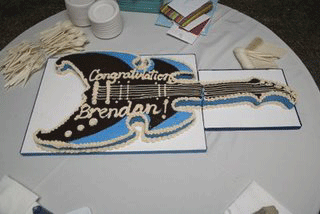
(Photo: Charles Kozierok)
GELLERMAN: Is there any part of the Jewish religion or heritage that’s green, that’s the basis of this?
HARRISON: Well the relationship between Jews and the environment goes back over 7,000 years, from the kashrut movement to stewardship of the earth type language in the Talmud and in the Torah.
GELLERMAN: Kashrut means kosher.
HARRISON: Yeah, kashrut is a whole system of laws about how to tend for animals and also the earth. So, for example, the organic movement and the kashrut movement overlap in that every seven years in Judaism you have to let the land fallow. And the idea of that is that the land needs to replenish itself and build up its nutrient base. And that really ties into the idea of the organic food movement where it’s all about soil fertility. So, these modern ideas really have a basis in ancient tradition.
GELLERMAN: Here’s one I really liked – a hemp kippur, that’s a yarmulke, skull cap you wear.
HARRISON: So hemp kippot are really fun. But one of my favorite ecofriendly Jewish focused elements that I’ve seen are these eco-suede kippot. And they’re actually made out of a recycled cardboard, but they’re very soft and they’re recycled. So most kippot are made out of sort of a velvet or a petroleum base, where eco-suede kippot or hemp kippot or silk kippot are all made out of sustainable materials.
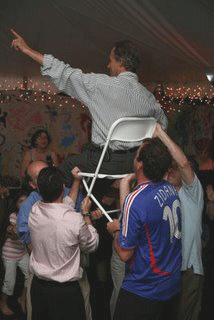
Brendan’s father lifted in a chair. (Photo: Courtesy of Kate Harrison)
GELLERMAN: I gotta tell you, Kate, the yarmulkes that I have are all recycled, they all come from somebody else’s bar mitzvah.
[LAUGHING]
HARRISON: And actually, you know, it’s funny you say that, because recycling is another form of being green. And instead of getting any kind of new kippot or tallis, you can borrow all that stuff.
GELLERMAN: Kate, does going green mean spending, you know, spending more green or can you save money?
HARRISON: This is a myth I’m working really hard to try to dispel that by making green choices you have to spend more. In fact, across the board I’ve found that you can save about forty percent off the cost of any party by going green.
GELLERMAN: Well Kate I want to bring Brendan Eprile into our conversation. He’s in Bennington, Vermont and was recently bar mitzvahed. Brendan, mazel tov!
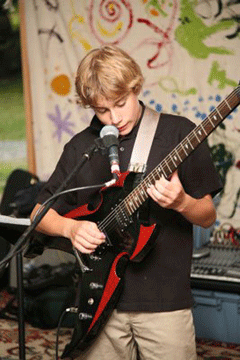
Brendan plays his solar-powered electric guitar at his green Bar Mitzvah. (Photo: Charles Kozierok)
EPRILE: Thank you.
GELLERMAN: So how green was your bar mitzvah?
EPRILE: Well, I don’t know on a scale from one to ten how green it was, but we had cardboard yarmulkes, recyclable. And we had compostable plates and compostable forks and cups made out of corn. And it was in a very green place that had solar power instead of regular power. So, I guess you could say it was green.
HARRISON: It was very green. Brendan was kind enough to let me write about his bar mitzvah on the site and it was a beautiful party and he had a lot of really very cool eco-friendly elements.
GELLERMAN: Brendan, I’m looking at some pictures of your bar mitzvah and is that your dad being lifted up in a chair.
EPRILE: Yeah.
GELLERMAN: So you have a cake in the shape of a guitar – do you play?
EPRILE: Oh yeah, I do play guitar.
GELLERMAN: Anything green about the cake.

The solar-powered setting. (Photo: Charles Kozierok)
EPRILE: Well, not the cake itself. But the guitar itself, when I played it, the amp was run by solar power because every single thing, like the lights, everything, was run by solar power. So I wasn’t causing an impact while I was playing guitar.
GELLERMAN: So how do the guests react to your green bar mitzvah?
EPRILE: Oh I think they liked it, but a lot of people ended up throwing out the plates in the garbage instead of the compost. A lot of people were just really happy about the beautiful setting and stuff.
GELLERMAN: Well, Kate, that brings up an interesting point. I mean, at a bar mitzvah you produce a lot of chazerai, a lot of garbage.
HARRISON: Oh, yeah. You know the average party produces about 600 pounds of waste. I should add that Brendan’s mother told me that she ended up digging through the garbage to pull those plates out and compost them, so… And one of the things that I talk about a lot and try to emphasize is that when you do make green choices like those plates, let guests know about it, because it’s an educational opportunity for them, and also then they won’t throw them away and you won’t have to go dig threw the trash. It can be a lesson. A lesson to us all. [Laughs]
GELLERMAN: Well, Kate, it’s been a lesson for me. Thank you very much.
HARRISON: Oh, thank you.
GELLERMAN: Kate Harrison operates the website greenbarmitzvahs.com.
And Brendan, thank you.
EPRILE: Thank you.
GELLERMAN: And mazel tov again. You’re now a man.
HARRISON: A green man.
EPRILE: Thank you.
GELLERMAN: Brendan Eprile lives in Bennington Vermont and was recently bar mitzvahed.
Links
Living on Earth wants to hear from you!
Living on Earth
62 Calef Highway, Suite 212
Lee, NH 03861
Telephone: 617-287-4121
E-mail: comments@loe.org
Newsletter [Click here]
Donate to Living on Earth!
Living on Earth is an independent media program and relies entirely on contributions from listeners and institutions supporting public service. Please donate now to preserve an independent environmental voice.
NewsletterLiving on Earth offers a weekly delivery of the show's rundown to your mailbox. Sign up for our newsletter today!
 Sailors For The Sea: Be the change you want to sea.
Sailors For The Sea: Be the change you want to sea.
 The Grantham Foundation for the Protection of the Environment: Committed to protecting and improving the health of the global environment.
The Grantham Foundation for the Protection of the Environment: Committed to protecting and improving the health of the global environment.
 Contribute to Living on Earth and receive, as our gift to you, an archival print of one of Mark Seth Lender's extraordinary wildlife photographs. Follow the link to see Mark's current collection of photographs.
Contribute to Living on Earth and receive, as our gift to you, an archival print of one of Mark Seth Lender's extraordinary wildlife photographs. Follow the link to see Mark's current collection of photographs.
 Buy a signed copy of Mark Seth Lender's book Smeagull the Seagull & support Living on Earth
Buy a signed copy of Mark Seth Lender's book Smeagull the Seagull & support Living on Earth

